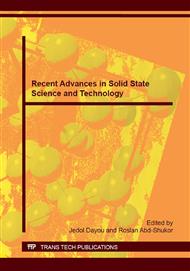p.1
p.9
p.15
p.21
p.27
p.33
p.39
p.45
p.59
Calculation of Electron Density Distribution in Cd0.5Zn0.5S by Density Functional Theory: Exploring its Bonding Character and Stability
Abstract:
The topology of electron density is a sketch that gives a clear picture about electronic distribution and details information of natural molecular bonding. In quantum mechanics or particularly in quantum chemistry, the electron density is a measure of the probability of an electron occupying at any infinitesimal element of space surrounding at any given point.Studies about the topology of electron density in Cd0.5Zn0.5S at plane (101) were conducted by the application of density functional theory (DFT) within linear augmented plane wave (LAPW) by using the WIEN2k software. In this calculation, generalized gradient approximation (GGA) methods were used to calculate the exchange-correlation potential of the electrons. Based on this calculation, the topology of electron density were presented in a contour plot (2D) and also inarelief map plot (3D) in order to see the way electron density, ρ of Cd0.5Zn0.5S defines the gradient field and hence the bonding type. From these plots, we identified the bond paths that coincide with the contours of electron to suggest that Cd0.5Zn0.5S exhibited characteristics of covalent and a slightly ionic bond character.
Info:
Periodical:
Pages:
21-25
Citation:
Online since:
June 2015
Authors:
Keywords:
Price:
Сopyright:
© 2015 Trans Tech Publications Ltd. All Rights Reserved
Share:
Citation:


